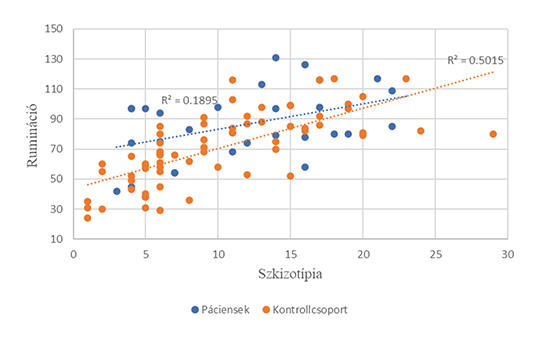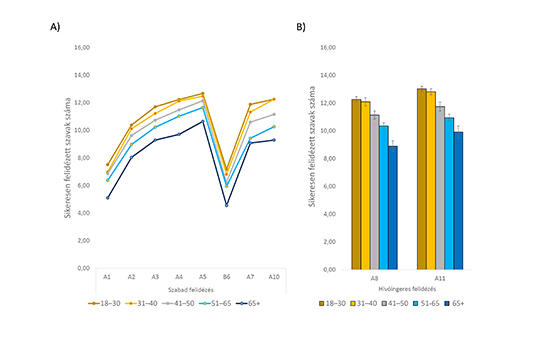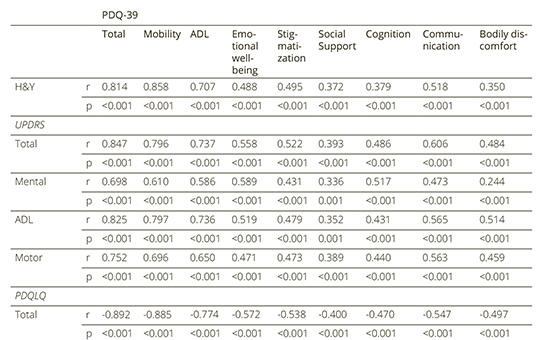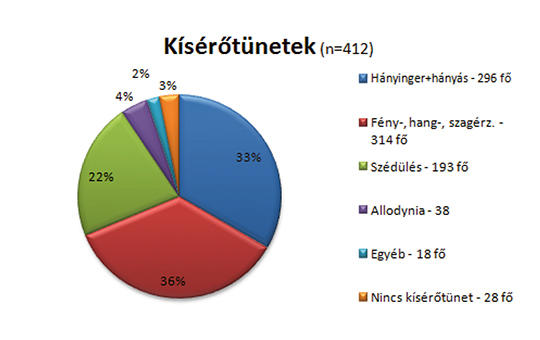The eLitMed.hu medical portal uses computer cookies for convenient operation. Detailed information can be found in the Cookie-policy.
Clinical Neuroscience - 2023;76(5-6)
Content
[Rumination and schizotypal personality traits]
[Although rumination and schizotypal traits can be considered transdiagnostic phenomena and can occur within non-clinical population as well, a relatively small number of research has been carried out on the topic involving both patient and non clinical participants. The aim of this study is to examine the relationship between schizotypal traits and rumination using a transdiagnostic approach, involving participants living with psychotic disorders and sine morbo individuals.
We recruited participants living with psychotic disorders (paranoid schizophrenia, hebephrenia, schizoaffective disorder, etc.) (n = 30) and controls who had not been diagnosed with any mental illnesses (n = 67). The connection between rumination and schizotypal traits was examined by self-report questionnaire method in a cross-sectional arrangement. The Oxford-Liverpool Inventory was used to measure schizotypal traits, and the Ruminative Thought Style Questionnaire was used to determine the level of rumination.
Schizotypal symptoms (β = 0.575; p < 0.001), especially cognitive disorganization (β = 0.459; p < 0.001) and unusual experiences (β = 0.221; p = 0.029) significantly explained the degree of rumination.
Our results support the hypothesis that the association between rumination and schizotypic traits is due to decreased cognitive inhibitory functions.]
[Verbal Episodic Memory Test]
[The decline of episodic memory is one of the earliest cognitive markers of mild cognitive impairment and various types of dementia. Until today, however, there is no standardized Hungarian episodic memory test that takes into account the characteristics of the Hungarian language. The study presents the structure and standardized use of a new memory test (Verbal Episodic Memory Test, VEMT) as well as normative data in Hungary.
The VEMT is suitable for the comprehensive examination of verbal learning abilities in a broader sense, and more specifically, for the neuropsychological measurement of verbal list learning abilities. In the present study, we constructed a normative database consisting of data from 385 participants.
We showed that the VEMT is sensitive to demographic factors (e.g., age) which are linked to differences in episodic memory performance. Open access to the test is provided, and the normative scores are presented as well.
The indicators of the test are suitable for drawing a learning curve, for showing the interaction of new and previously learned information (interference effects), and for measuring differences between free recall and cued recall. Furthermore, the test scores are appropriate for distinguishing the effects of different types of memory encoding forms (phonological, semantic, and episodic), for measuring the ability to reconstruct the presentation of a sequence (memory order information), for detecting the rate of forgetting, for measuring recognition abilities, and for detecting hippocampus-related mnemonic pattern separation and completion functions. ]
Effects of the combined treatment of bilateral subthalamic nucleus stimulation and levodopa on balance and mobility in Parkinson’s disease
Background and purpose – To evaluate the efficacy of the combined therapy of bilateral subthalamic nucleus deep brain stimulation (STN-DBS) and dopaminergic medication on balance and mobility in patients with Parkinson’s disease (PD).
Reliability and validity of the Turkish version of the 39-item Parkinson Disease Questionnaire
This study aims to investigate the validity and reliability of the Turkish Version of the 39-item Parkinson Disease Questionnaire. A total of 100 patients with Parkinson’s disease who were admitted to the outpatient neurology clinic in Koc University and Istanbul University were enrolled. 39- item Parkinson Disease Questionnaire, Parkinson Disease Quality of Life Questionnaire, Unified Parkinson’s Disease Rating Scale, Hoehn-Yahr Scale, and Short Form Health Survey-36 were administered to all participants.
Clinical significance of serum lncRNA H19, GAS5, HAR1B and linc01783 levels in Parkinson’s disease
Long noncod- ing RNAs (lncRNAs) are highly expressed in the brain and alterations in their levels have been shown in many neurodegenerative disorders. Evidence has shown that lncRNAs play role in the onset and progression of Parkinson’s disease (PD) and it can be used as a potential therapeutic target. Our purpose was to detect whether the serum levels of four candidate lncRNAs H19, GAS5, HAR1B and LINC01783 are related with the clinical findings and treatment of PD or not.
[The new target population of stroke awareness campaign: Kindergarten students ]
[ Thrombolysis and/or thrombectomy have been proven effective in the treatment of acute ischemic stroke. Due to the narrow time window, the number of patients suitable for these treatments is low. The main limitation is the pre-hospital stage, few people call an ambulance in time. The delay may be caused by the population’s insufficient health knowledge, but also by the loneliness and isolation of the population most prone to stroke. Among the latter, there are many grandparents who spend considerable time with their grandchildren. This gave rise to the idea of educating even younger children about the symptoms of a stroke, enabling them to call an ambulance if necessary. To this end, we adapted the Angels Initiative project previously tested in Greece. The Hungarian pilot study Budapest District XII. took place in district kindergartens. The Angels’ original role-playing program could not be implemented due to the COVID epidemic, so the necessity called for a new, Hungarian version: the online “Stroke Ovi” program. We introduced this in several stages, and in the third we also carried out an impact study.
We adapted the Angels Initiative’s international program and its Hungarian translation to our program. We prepared the original, live role-playing form, with a parent meeting in the selected “test kindergarten”. Due to the uncertainly lingering impact of the COVID epidemic, we reevaluated our plan, using the Hungarian storybook and take-home workbook created in the meantime, we developed our own online version in several kindergartens in Budapest. We held 10 and then 25 minute sessions a week for 5 weeks. In the third educational cycle, which always targets new groups, we already examined the impact of the program by taking pre- and post-tests, in which not only the children but also their parents participated. In addition to neurologists and kindergarten teachers, we also included psychologists and speech therapists in our work, because we believed that in a social environment that includes parents and children, results can only be achieved through multidisciplinary cooperation.
In the third cycle of the program, tests were taken before (pre-test) and after (post-test) among children and their parents. We only took into account those answers where we received an evaluable answer in the survey before and after the program. Our most important results: 1. there was no negative change in any question, so it was not the case that the total score of any question in the pre-test was higher than in the post-test. 2. The children learned that not only adults can call the ambulance. 3. Before the program, all children were already aware that if “someone is very ill”, the ambulance should be called. 4. Among the questions about stroke symptoms, it is important that hemiparesis, facial paresis and speech/language disorder are clear symptoms for children. Based on the parental questionnaires, the knowledge of the adults can be judged to be very good. The same number of correct answers were received during the pre-test and the post-test, on the basis of which we could not calculate a transfer effect. However, it is important that the parents considered the program useful, motivating and important for the children, so cooperation can be expected in the future.
The Hungarian “Stroke Ovi” program has so far proven to be clearly effective. This was proven by the impact assessments even if, instead of the original role-playing game, we implemented it “only” online due to the COVID epidemic. This constraint also forced and created a new “Hungarian version”. Despite the small number of samples caused by the circumstances, we consider this positive effect to be measurable. However, as the main result and evidence, we evaluated the children’s reaction, which took shape in spontaneous drawings and displayed professional values in addition to positive emotional reactions, such as the drawing of ambulances, the recurring representation of the 112 number. With the involvement of the media, we think online education is also a good option in the series of stroke campaigns, but we think the original role-playing form is really effective. At the same time, we can see that the application of the new method requires great caution due to the education of developing children. For this reason, results can only be achieved through social and multidisciplinary cooperation involving neurologists, psychologists, kindergarten teachers, and parents.]
[Headache registry in Szeged: Experiences regarding to migraine patients]
[Using patient registries is essential both in clinical research and in medical practice. Headaches, more specifically migraines are one of the most common complaints that can detract the quality of a patient’s life and these complaints also have a significant socio-economic effect. Our goal is to create a national Headache Registry and to also provide the pre-analysis of the registry’s database.
Our research is based on the national Multiple Sclerosis Registry, which we modified using the latest version of diagnostic criteria published by the International Headache Society. This clinical study contains data collected from patients suffering from migraines and currently receiving care at the Headache Outpatient Department at the Neurologic Clinic of the University of Szeged.
The data of 412 patients (363 women and 49 men) suffering from migraine (migraine without aura: n = 313 and migraine with aura: n = 99) were added to the Headache Registry. The average age of participants was 44.1 ± 12.5 SD years. Regarding the attributes of migraine headaches we examined the following characteristics: localization, quality and intensity (based on the Visual Analogue Scale) of the pain, frequency (the number of headache days per month), medications (acute or prophylactic), comorbidities (depression, anxiety, hypertension, asthma, epilepsy and others), family history and the occurrence of stroke among patients.
Based on international experience, patient registries are the most optimal systems for structured patient monitoring. For high level management and long-term follow up of the patients the application of registries is essential. The registries include the detailed medical history and the diagnostic and therapeutic data of the patients, and they trace the changes during the follow up medical visits. Registries are able to record the entire course of the disease in digital way. The numerous data can be set out any time from the digital database. Extensive spread of patients’ registries is fundamental not only in every day clinical practice, but also in clinical research.]
Is autism spectrum disorder an inflammation?
In our study, we aimed to evaluate inflammation by measuring serum Adenosine deaminase and dipeptidyl peptidase IV levels of individuals diagnosed with autism spectrum disorder and to determine its relationship with the Childhood Autism Rating Scale.
37 children aged 2-12 years with a diagnosis of autism spectrum disorder and 27 children aged 2-12 years without any psychiatric disease were included in the study. Psychiatric examination and clinical evaluation according to DSM-5 diagnostic criteria for the diagnosis of autism spectrum disorder were performed on the children included in the study. The Childhood Autism Rating Scale was filled in by the researcher by interviewing the parents of the children diagnosed with autism spectrum disorder. 5 ml of venous blood samples were taken from the children in both groups in the morning on a full stomach.
There was no statistically significant difference between the groups in terms of age, gender, and sociodemographic data. While serum adenosine deaminase levels were found to be statistically significantly higher in the group with autism spectrum disorder, serum dipeptidyl peptidase IV levels were found to be significantly lower. A positive correlation was found between dipeptidyl peptidase IV and Childhood Autism Rating Scale.
We think that inflammation may play a role in the etiology of autism spectrum disorder due to altered adenosine deaminase and dipeptidyl peptidase IV levels in children with autism spectrum disorder.
1.
Clinical Neuroscience
Is there any difference in mortality rates of atrial fibrillation detected before or after ischemic stroke?2.
Clinical Neuroscience
Factors influencing the level of stigma in Parkinson’s disease in western Turkey3.
Clinical Neuroscience
Neuropathic pain and mood disorders in earthquake survivors with peripheral nerve injuries4.
Journal of Nursing Theory and Practice
[Correlations of Sarcopenia, Frailty, Falls and Social Isolation – A Literature Review in the Light of Swedish Statistics]5.
Clinical Neuroscience
[Comparison of pain intensity measurements among patients with low-back pain]1.
2.
Clinical Neuroscience Proceedings
[A Magyar Stroke Társaság XVIII. Kongresszusa és a Magyar Neuroszonológiai Társaság XV. Konferenciája. Absztraktfüzet]3.
4.
Journal of Nursing Theory and Practice
[A selection of the entries submitted to the literary contest "Honorable mission: the joys and challenges of our profession" ]5.
Journal of Nursing Theory and Practice
[End of Life and Palliative Care of Newborns in the Nursing Context]










